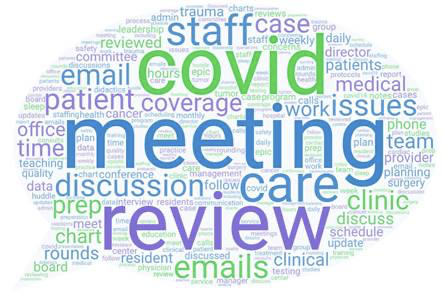By GAIL PEACE
We have heard the phrases “physician fatigue” and “burnout” too often in the last year – and for good reason. Covid-19 has placed an incredible burden on our healthcare providers. However, as healthcare professionals, the stats representing physician burnout are not new for us.
We have seen similar trends and stats for years. Covid-19 did not cause the current state of physician burnout, it has just exacerbated it and further exposed critical issues with the expectations placed on physicians in today’s healthcare system. Ludi conducted a survey of physicians across the country confirming that exact theory:
- 68 percent of physicians feel pessimistic or indifferent about their occupation
- 48 percent describe the relationship with their hospital partners/employers as combative or transactional at best
We need to ask ourselves: What is actually causing this dissatisfaction and how can hospitals better align with their physician partners?
According to the physicians surveyed, 68 percent agreed they have too much administrative burden placed on them. More often than not, our industry blames EHRs for dominating administrative time, but from the physicians we surveyed, EHRs are just part of the problem. In fact, 54 percent of physicians indicated they spend 1-3 hours per day on administrative work outside of EHR time, with another 35 percent spending more than 4 hours per day on similar tasks.
Let’s put that into perspective. On top of seeing patients, charting in EHRs, and all the other things physicians are expected to do to take care of patients, physicians are also spending at least another 1-3 hours per day on “everything else.” This everything else includes meetings, training, compliance, policy, etc.
We are asking our physicians to do too much. It’s no wonder they are burnt out.

SOURCE OF DATA: Ludi Inc. compiled data on administrative work performed by more than 1,200 physicians between May 2020 and May 2021 that was logged through Ludi’s DocTime

Suite. The notes entered directly by physicians represent how physicians spent their time for the last year when they weren’t seeing patients – as depicted in the word cloud. To better align with physicians, hospitals need to empower physicians to focus on what they do best and appropriately pay them for that work.

SOURCE OF DATA: Ludi, Inc. surveyed 100 random physicians in the United States currently employed by a hospital or a medical group or independent physicians contracted with a hospital.
The numbers speak for themselves and the ball is in the hospitals’ court to work with physicians to help them focus on patient care. In response, we are already seeing unprecedented levels of compensation redesign across the industry to better align physician and hospital priorities. But these comp redesigns are just part of the solution. There’s plenty of low-hanging fruit that hospitals can leverage to improve their physician relationships right now – and it all starts with reducing administrative burden.
First, hospitals should consider how and where technology can be used effectively within the nuances of their operations. They can start by asking themselves a few key questions, such as: Are there tasks or processes physicians are doing on paper right now that could be automated? What does this manual process involve and how does it impact different departments? What are the most time-consuming tasks for physicians each day, each month?
Of course, hospitals should also make sure the reason they’re implementing new automation in the first place is clear to them. That is, they should be solving for specific pain points (and agree on the priority of those pain points), and with direct feedback from the stakeholders themselves, in this case, physicians. If a hospital implements a solution that doesn’t take into account the physician’s daily routine or workflow, then it’s likely the new automation will fail. And when you’re dealing with doctors, you want to make the solution is as easy and quick as possible, given everything else they have to deal with throughout the day.
The fact of the matter is though, when it comes to automation technology, more than 83 percent of physicians we surveyed agreed automation technology focused on reducing administrative workloads will improve their productivity and job satisfaction. That’s good news for hospitals.
Why? Because the less time physicians are spending on administrative tasks means more time spent with patients and other more meaningful tasks. And that’s a win-win for everyone.
At the end of the day, hospitals should always be focused on what else they can do to support their employees from a morale perspective. I worked for health systems where we had an option to drop off dry-cleaning in the lobby – a simple task but something that physicians may not have time for given their demanding schedules. Now, take that example, apply it to the big picture, and go for it.
So, what are you waiting for?
Gail Peace is founder and CEO of Ludi, Inc., a health care technology company making it easier for hospitals to pay physicians.
-----------------------------------------
By: Christina Liu
Title: We are Asking Our Physicians to Do Too Much. It’s No Wonder They are Burnt Out.
Sourced From: thehealthcareblog.com/blog/2021/11/01/we-are-asking-our-physicians-to-do-too-much-its-no-wonder-they-are-burnt-out/
Published Date: Mon, 01 Nov 2021 12:58:50 +0000
Read More
Did you miss our previous article...
https://prohealthsciences.com/general-health-and-wellness/reflections-on-hlth2021-the-lens-of-the-carepartner-and-the-patient
 General Health and WellnessFitness and ExerciseSupplements and VitaminsPandemic NewsVideosPrivacy PolicyTerms And Conditions
General Health and WellnessFitness and ExerciseSupplements and VitaminsPandemic NewsVideosPrivacy PolicyTerms And Conditions
